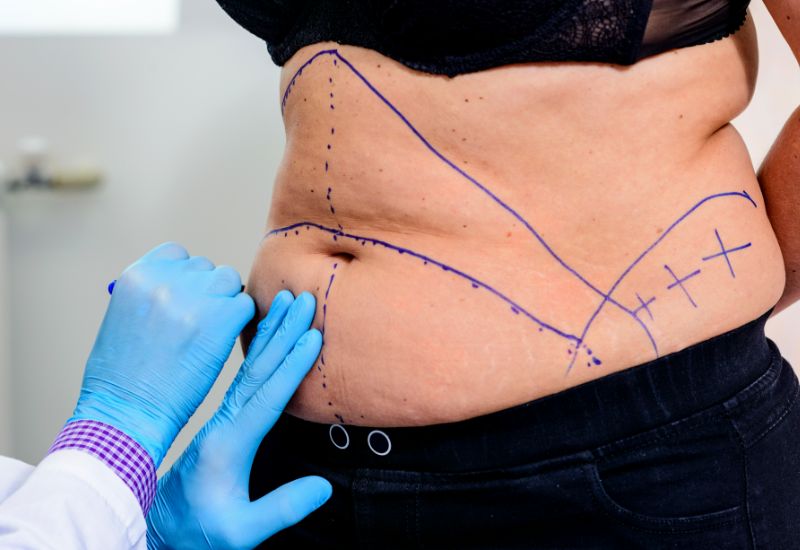A tummy tuck, also known as abdominoplasty, is a cosmetic procedure which involves the removal of excess skin and fat in the abdominal area.
It’s a procedure that is usually done along with liposuction, to help get rid of the excess fat.
A tummy tuck should be used in conjunction with a balanced diet and exercise to keep the abdominal area flat.
It’s not a quick fix for losing weight.
In this article, we’ll go into depth about tummy tucks and what is involved with the procedure along with some risks and benefits.

Overview of tummy tucks
Tummy tucks are usually sought by people who have experienced significant weight loss, pregnancy, or ageing, which can result in loose or sagging abdominal skin.
During a tummy tuck, the surgeon typically makes an incision in the lower abdomen, often from hip to hip, to remove excess skin and fat.
In some cases, the surgeon may also tighten the abdominal muscles, especially if they have become stretched or separated. The remaining skin is then repositioned, and the incision is closed.
Depending on the extent of the procedure, there are different types of tummy tucks, including a full tummy tuck and a mini or partial tummy tuck.
It’s essential to note that a tummy tuck is a surgical procedure with associated risks and a significant recovery period.
If you’re planning on having more children then you should not get a tummy tuck as pregnancy can restretch the skin and muscles.
Why do people get a tummy tuck?
There are many different reasons for wanting to get a tummy tuck.
The main reasons are usually centred around the desire to achieve a more contoured and aesthetically pleasing abdominal appearance.
Doing so is a great way to enhance your body image, boost self-confidence, and regain a more youthful and proportionate body shape.
Other reasons include:
- When you experience weight loss there can be excess fat deposits and skin leftover.
- Pregnancy and childbirth can also lead you to seek a tummy tuck, as the abdominal muscles may become stretched and separated during the journey to parenthood.
- Ageing can result in a loss of skin elasticity, leading to sagging in the abdominal region.
Where on the body can you get a tummy tuck?
The primary area addressed during a tummy tuck is the lower part of the abdomen, typically from the pubic bone to the belly button or even extending to the hips.
The procedure involves removing excess skin and fat and, in some cases, tightening the underlying abdominal muscles.
While the focus is on the front of the torso, the effects of a tummy tuck can have a transformative impact on the overall contour of the midsection.
Different types of tummy tuck procedures
There are different types of tummy tuck procedures. The choice of the specific technique depends on factors such as your anatomy, goals, and the extent of correction needed.
Here are some common types of tummy tuck procedures:
Standard abdominoplasty ‘full tummy tuck’
A full tummy tuck is designed to improve the lower and upper abdomen and is the most common type of tummy tuck.
It involves an incision made from hip to hip, just above the pubic area. The surgeon separates excess skin and fat from the abdominal muscles.
Then tightens the abdominal muscles with stitches.
A second incision will also be made around the belly button. Doing so helps reposition it when your skin is pulled together.
Any excess skin will then be removed, giving you a flatter more contoured midsection.
Modified abdominoplasty ‘mini tummy tuck’
Modified abdominoplasty, often referred to as a modified tummy tuck, is a customised approach to abdominoplasty that tailors the procedure to meet your specific needs.
This variation of the traditional tummy tuck involves adjustments to the standard technique based on factors such as the extent of excess skin, muscle laxity, and your cosmetic goals.
The surgeon may focus on specific areas of concern, adapting the incision pattern and tissue manipulation accordingly.
Modified abdominoplasty allows for a more personalised and targeted contouring of the abdominal region.
This makes it a versatile option if you don’t require a full abdominoplasty or if you have unique anatomical considerations.
Extended abdominoplasty and flankoplasty ‘extended tummy tuck’
This procedure addresses your abdomen as well as your flanks or love handles.
The incision will be similar to a full tummy tuck but the incision will extend to your sides so that your flanks can be treated.
This procedure is suited if you’re someone who has excess skin and fat not only around the front of their abdomen but at the side of it also.

Fleur-de-Lis tummy tuck
This is a specialised variant of the traditional abdominoplasty that is designed to address significant excess skin and tissue both horizontally and vertically.
Patients who have experienced significant weight loss will usually benefit from a Fleur-des-lis tummy tuck.
The name comes from the shape of Fleur-de-lis, which is French for a Lily flower.
A Fleur-de-Lis procedure involves not only the standard horizontal incision along the lower abdomen but also a vertical incision that intersects it.
This unique incision allows surgeons to remove excess skin in two dimensions, providing a more comprehensive solution for individuals with substantial sagging skin and laxity.
The Fleur-de-Lis tummy tuck is often recommended for patients with excess skin not only along the waistline but also extending vertically.
While it leaves more visible scarring compared to other tummy tuck techniques, it offers a transformative solution for patients seeking comprehensive abdominal contouring.
The benefits of a tummy tuck
A tummy tuck, or abdominoplasty, can offer several benefits for individuals seeking to improve the appearance of their abdominal area.
Some of the key advantages include:
Improved posture and core strength
Your abdominal muscles can weaken and even detach when going through pregnancy or weight loss.
Sometimes with diet and exercise, these muscles can still be unresponsive.
Strengthening and tightening the abdominal muscles during a tummy tuck can contribute to better core support, potentially improving posture and reducing discomfort or strain in the lower back.
Increased self-confidence
Getting a tummy tuck can boost your self-esteem and body confidence.
The reason for getting the procedure done in the first place will be due to excess skin and fat.
Once you get a tummy tuck you should experience a more proportionate and contoured midsection.
If you’re happy with your results then you’ll feel the effects of this emotionally as you become more body confident.
You’ll be able to wear clothing you never could before, allowing you to expand your wardrobe, try new styles, and feel more confident in what you wear.
Can help you maintain a healthy lifestyle
When you invest in a cosmetic procedure you will want to keep the results that you receive as a result of the surgery.
Doing so will mean maintaining a healthy lifestyle with diet and exercise.
Therefore, getting the procedure can be a great motivator to help you do this.
You won’t want to invest in this type of procedure only to lose results due to a poor diet and exercise.
The risks of a tummy tuck
Like any surgical procedure, a tummy tuck comes with potential risks and complications. Thankfully there are ways that we can manage these complications in abdominoplasty.
Here are some common risks associated with tummy tuck surgery include:
- Infection – Any surgical procedure carries a risk of infection. Proper postoperative care, including hygiene and prescribed antibiotics, can help minimise this risk.
- Bleeding – Excessive bleeding during or after surgery is a potential complication. Our surgeons take precautions during the procedure to control bleeding, and you’re monitored closely during the initial recovery period.
- Poor Wound Healing – Compromised blood flow to the incision sites can lead to delayed or poor wound healing. Studies have shown this risk may be influenced by factors such as smoking, diabetes, or certain medical conditions.
- Seroma Formation – Seromas are pockets of clear fluid that can accumulate under the skin at the surgical site. Draining may be necessary if a significant seroma develops.
- Hematoma – This involves the collection of blood outside of blood vessels, forming a localised clot. Hematomas can lead to swelling, pain, and in severe cases, may require drainage.
- Numbness or Altered Sensation – Some patients may experience temporary or permanent changes in sensation, including numbness or tingling, in the abdominal area. This is typically due to nerve damage during surgery.
- Asymmetry – Achieving perfect symmetry in the abdominal area can be challenging, and there is a risk of subtle asymmetry after surgery. Additional procedures may be needed to address any noticeable disparities. Studies have been conducted which identify silent seromas as a potential cause for scar asymmetry.
- Anaesthesia Risks – General anaesthesia, which is commonly used in tummy tuck surgery, carries its own set of risks, including allergic reactions and respiratory issues.

Tummy tuck consultations with The New Birkdale Clinic
Tummy tuck procedures can give transformative results that leave your midsection feeling firmer and looking more contoured.
It’s a common procedure in the cosmetics industry that has some of the most impactful results.
At The New Birkdale Clinic, we have helped many new patients over the years completely transform their body shapes using tummy tuck procedures.
Our medical staff and surgeons are some of the best in the world and we have all of the latest technology and equipment at our disposal.
If you’re interested in getting a tummy tuck please contact us today and we can go through an initial consultation with one of our surgeons.
